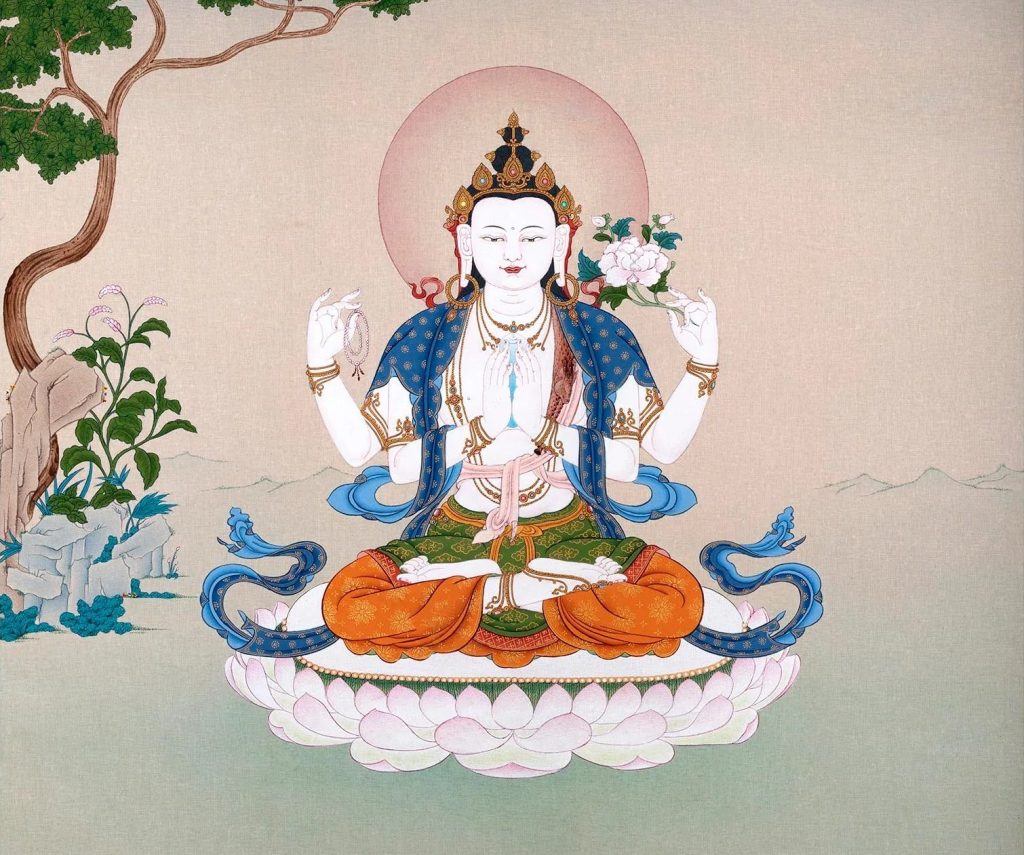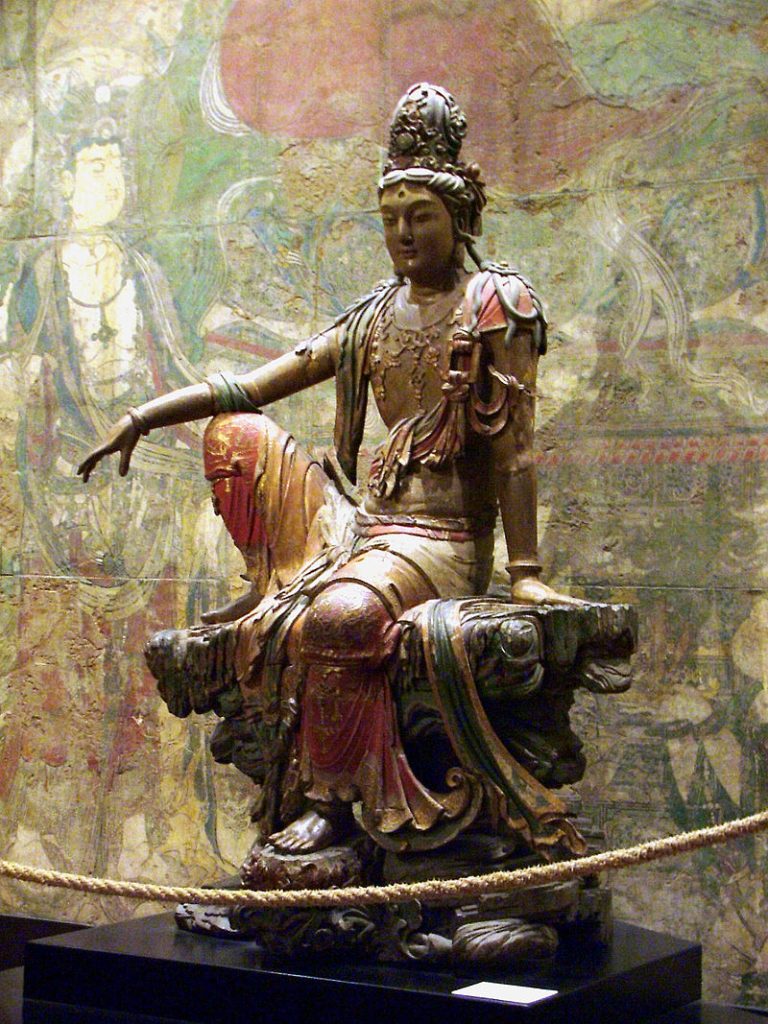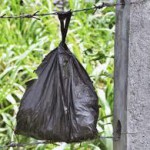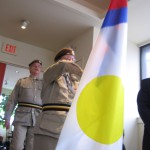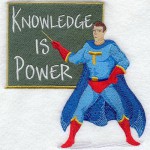Tuesday
Meeting Chenrezig in Sound: Understanding Chenrezig’s Name and the Meaning of the Chenrezig Mantra
by Frederick Meyer
An excerpt from the Shambhala Online Blog posted April 12, 2024
In recent years, Chenrezig—the Tibetan name for the Buddhist deity Avalokiteshvara, the Bodhisattva of compassion—has become an important part of my spiritual practice. I have a strong affinity for sound, and much of my learning about Chenrezig has been in the form of sound and meaning: what “Chenrezig” itself means and how it relates to Avalokiteshvara’s other names, what the Sanskrit and Tibetan versions of the word compassion actually mean, and the meaning of the famous Chenrezig mantra OM MANI PADME HUM.
In this article, I want to share both what I’ve learned about Chenrezig himself, as well as my own process of exploration. I feel the process I’ve followed shows how association and meaning can unfold along the Buddhist path, especially the parts of the path that are rich in energy and iconography.
Throughout this article, I’ll be describing what I learned about Chenrezig in my explorations , as well as weaving in Chögyam Trungpa Rinpoche’s teachings on the same topic. I only discovered Trungpa Rinpoche’s teachings on Chenrezig within the past month, so it’s been very interesting to compare my own independent learning with his teaching, and I hope to illustrate that dynamic as well.
Chenrezig: First Connections
I had heard of Chenrezig growing up, but I didn’t connect strongly to Chenrezig until around three years ago, when my father, a longtime Buddhist practitioner, began practicing Four-Armed Chenrezig sadhana practice with a Tibetan Lama living in Hawaii. At his suggestion, I began joining for the weekly sadhana practice.
The lama often played a YouTube video (with the sound off) during the visualization part of the sadhana. The video includes a thangka of Chenrezig that I really like—something about the eyes and facial expression, and the vibrant colors. I found that looking at it gave me a certain feeling, and I began to carry that with me.
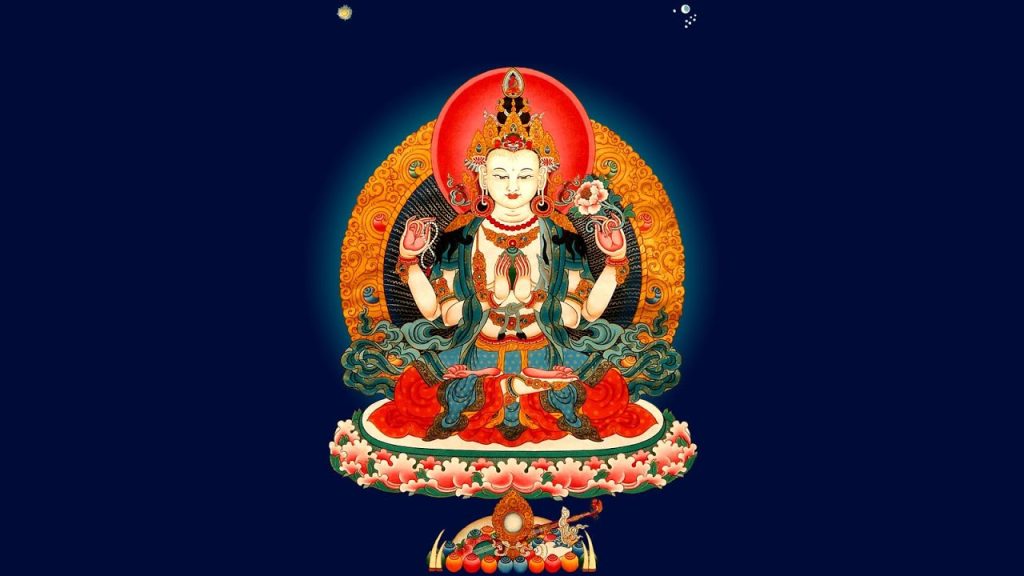
Because of his enthusiasm for the practice, I gifted my father a Chenrezig thangka for one of his birthdays, and then later bought one for myself. When my thangka arrived (about a year and a half ago now), I found that the energy of my own interest in and connection with Chenrezig heightened significantly.
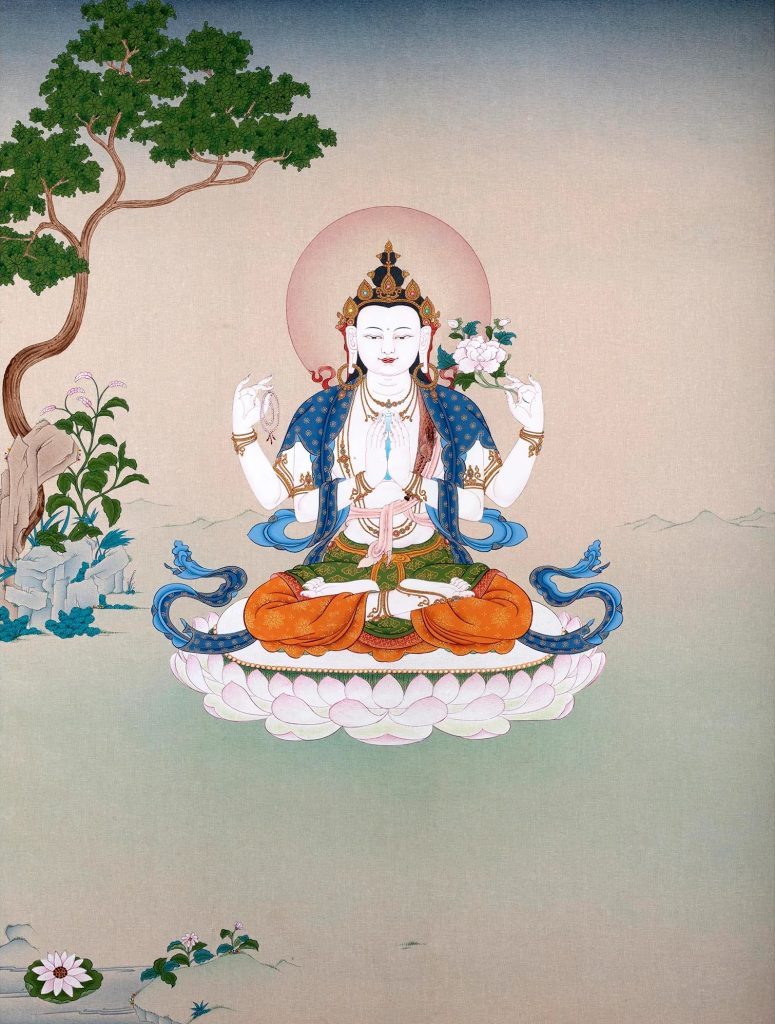
From there, I began exploring Chenrezig in earnest, and that’s where I began to learn in depth about Chenrezig’s name, the meaning of compassion, and the meaning of the Chenrezig mantra.
Chenrezig: What the Name Means
The Tibetan name Chenrezig means “continuously looking,” and has been translated as:
- “One who looks with unwavering eye”
- “Unblinking Eyes”
- “One who always looks upon all beings (with the eye of compassion)”
Trungpa Rinpoche translates Chenrezig as: “He Who Sees All Sentient Beings.”
Chenrezig is the Tibetan version of the Sanskrit name Avalokiteshvara, which means “lord who gazes upon the world.” The idea of this name (in both Sanskrit and Tibetan) is that the loving gaze of compassion—the gaze of Chenrezig, compassion itself—forever holds all beings.
Avalokitasvara: The Female Compassion Deity
What I find most interesting about Chenrezig’s name is that there is another form of the Sanskrit name Avalokiteshvara. Wikipedia does a wonderful job summarizing the history, and it felt like a major revelation to me when I read it. The other name is Avalokitasvara: “Who hears the cries of the world.”
Western scholars originally thought this name had been made up, in error, by Chinese translators from Sanskrit, who named the deity Guanshiyin, “[The One Who] Perceives the Sounds of the World,” or “who perceives the world’s lamentations.” Shortened to Guanyin (and later rendered in Japan as Konan), this is the contemporary Chinese name for Avalokiteshvara, who is represented as a female compassion deity.
Scholars later realized that Avalokitasvara is actually a correct—and older—name of the deity, which was later developed into Avalokiteshvara (adding the sense of “lord” and changing “hear” to “see”). Guanshiyin, “Who Hears the Cries of the World,” wasn’t a mistranslation at all.
As I mentioned, I have a strong affinity for sound, and learning this alternate name of Chenrezig had a profound effect on me. One who gazes (lovingly) upon the world sounds, to me, nice but a little distant—but “hearing the world’s cries” carries a strong feeling I can immediately connect with.
In fact, many of my most immediate and piercing experiences of compassion have been sound-based. As an example, I have a small dog, and this morning when I picked her up, she yelped loudly (I don’t know why, and she wasn’t hurt). I was immediately pierced by a feeling that was so immediate I didn’t have a name for it. I feel it was a strong hit of compassion—the powerful, immediate, primordial feeling that is true compassion, not the refined notion of charity and concern for others that we might often think of.
To continue reading Meeting Chenrezig in Sound: Understanding Chenrezig’s Name and the Meaning of the Chenrezig Mantra by Frederick Meyer please visit the Shambhala Online Blog webpage here.
Entries filed under Community Articles
Carta de Lady Diana Mukpo
Queridos miembros de la Comunidad Shambhala: Les escribo con un corazón apesadumbrado. Este es un momento increíblemente doloroso para todos nosotros. Sin embargo, de muchas maneras, siento que la situación en la que nos encontramos como comunidad era inevitable. La profunda disfunción y la falta de amabilidad ... continuePosted February 22, 2019 by luz_rodriguez
Letter from Lady Diana Mukpo – HIGHLIGHT
Dear Members of the Shambhala Community, I write to you today with a very heavy heart. This is an incredibly painful time for all of us. However, in many ways, I feel that the situation we find ourselves in as a community was inevitable. The deep dysfunction ... continuePosted February 19, 2019 by Ashley_Dinges
Tocar la tierra, chispear tristeza y alegría
Ayer… “El medio oeste de EE. UU. pasa por un frio polar mientras que Australia se quema, bienvenidos a la era de la meteorología extrema”. Ese foto de Irene Woodard fue el titular de primera página en la versión digital del New York Times hace unos días. Al lado ... continuePosted February 14, 2019 by luz_rodriguez
Touching the Earth, Sparking Sadness and Joy – HIGHLIGHT
Este artículo ha sido traducido al español aqui. Yesterday… “As midwest freezes and Australia burns, welcome to the age of weather extremes.” This was on the front page of the digital version of the New York Times yesterday. Next to it, a video looking at the polar vortex, ... continuePosted February 11, 2019 by archives-staff
Kyudo is Not a Shambhala Art – HIGHLIGHT
Sensei illustrates the position of the arms in kyudo: a circle, meaning “peace.” article by Carolyn Kanjuro photos courtesy of Sue Kranzdorf Kyudo, “standing meditation” engaging the warrior’s implements of bow and arrow, has been considered the highest form of samurai training for hundreds of years in Japan. Deeply ... continuePosted December 25, 2018 by alexandra_kalinine
How Should a Buddhist Respond to “Merry Christmas”? – HIGHLIGHT
article by Chris Montone, Washington, D.C. For those of us who have formally taken refuge and changed our religious affiliation to Buddhism, the end of the year holiday season can pose some interesting challenges — one of which being, what to say in response to the myriad ... continuePosted December 23, 2018 by alexandra_kalinine
Home Shrines Are Where We Gather – HIGHLIGHT
A photo gallery of home shrines, courtesy of Shambhalians around the world who shared the images below. The ordinariness of our Shambhala Households are as powerful as they are mundane. But the practices and implements of modern life – dishwashers, electric stoves, washing machines, and hair dryers ... continuePosted December 9, 2018 by Jennifer Holder
Setting up a Home Shrine – HIGHLIGHT
COLUMN: Good Practice by Sumner Bradley, long time employee at Samadhi Cushions To begin with, if you don’t have a shrine, that’s fine. You want to have a space that’s clean, uncluttered, and uplifted. Having dirty socks or old magazines lying around is a distraction and a weight ... continuePosted December 4, 2018 by alexandra_kalinine
Talking Trash – HIGHLIGHT
Commemorating Earth Day by Anenome Fresh resident gardener at Karme Choling One afternoon in mid-January, I decided to start taking accountability for the trash I produce. I was tired of mindlessly taking a paper napkin with every meal, most usually not using it or needing it. I used a ... continuePosted December 2, 2018 by alexandra_kalinine
The Fullness of Full-Catastrophe Living – HIGHLIGHT
Healthy Road. Photo courtesy of Jennifer Holder. By Paulette Graf In the 1970’s I lived with my husband at the Cambridge Zen Center where we became friends with Jon Kabat-Zinn. Jon was active at the Zen Center although he lived in his in his own home with his ... continuePosted November 27, 2018 by paulettemgraf
Farewell to the Marvelous Dhi Good
Eve Rosenthal, Dhi Good, and Heather Scott In 2012, after six years at the helm of our established, yet still fledgling, Shambhala Online, I was ready to retire and hand over the reins to the next generation of techno-savants, those visionaries who would play in the “big ... continuePosted November 8, 2018 by Mark_Whaley
Transforming Aggression into Gentleness – HIGHLIGHT
Rusung McCorkle, Shambhala Day 2011 by Brian McCorkle Have you ever been at a Shambhala program and experienced seeing official-looking people who look like they are in uniform? It may have been blue blazers with pins, white shirts, khaki or grey slacks, standing off to the side, or ... continuePosted October 25, 2018 by alexandra_kalinine
Buddhism and Nonviolent Communication – HIGHLIGHT
“Beautiful Needs” calligraphy created by Barbara Bash, www.barbarabash.com. Courtesy of Roberta Wall, www.steps2peace.com Written for the Dot by Jason Leslie Openness is not a matter of giving something to someone else, but it means giving up your demand and the basic criteria of the demand … It is ... continuePosted October 18, 2018 by alexandra_kalinine
Is Knowledge Power? – HIGHLIGHT
by Larry Barnett Having taken the Sakyong’s suggestion about becoming experts on society and understanding the nature of self, I’ve been immersed in re-reading Western philosophy and exploring the roots of our western conceptions about self and society. Accordingly, the shift towards a materialist view that took ... continuePosted October 14, 2018 by Larry Barnett
Fun and Belonging – HIGHLIGHT
Our experience at Enlightened Society Assembly in Austin, Texas by Aarush and Aarnav Uli, ages 7 and 11 This year my brother and I attended the Enlightened Children’s Program (ECP) at the Austin Shambala Center, led by Shastri Iris Ramos, with volunteers Christian Mitchell, Davis Maynard, and Miya Little. A ... continuePosted September 6, 2018 by CGH
![]() RSS feed for the Community Articles category
RSS feed for the Community Articles category
View all posts from authors in Community Articles: Jillian_Johnson

